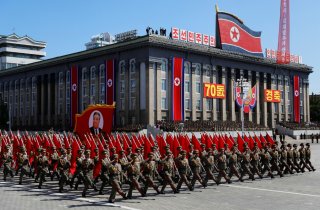In the 1960s, Kim Il-sung Sent Terrorists to Overthrow South Korea
By the close of the decade, Kim Il-sung had sent hundreds of communist spies and commandos to the ROK
CIA reporting indicated that the troops were supposed to stay for a little over a week followed by a nearly three week trek up north to cross the DMZ and return home. Pyongyang had tasked them with collecting intelligence on the ROK military, scouting for locations that could be used as bases for future operations and recruiting local intelligence sources.
The soldiers divided up into teams and spread out. One of them seized the residents of a local village and carried out a communist indoctrination session, making the locals apply to be members of the Korean Workers Party. In front of the assembled crowd, the commandos picked out a man and beat him to death as an act of propaganda.
In a later report, the CIA noted grimly that it was “ the first instance of armed propaganda since the Korean War.”
South Korean security forces sprung into action and in the weeks that followed began hunting down the infiltrators. The hunt claimed the lives of 63 civilians but it was an even bigger disaster for the 124th. Of the 120 soldiers who had landed on Ulchin, only seven were taken alive. South Korean forces killed 110 of them and just three remained unaccounted for.
After the landing, the CIA worried about the prospect of more large-scale raids. North Korea was expanding its paramilitary forces and adding winter training to their curriculum — a sign that it could be gearing up to press through the usual lull in operations that came in winter.
A few months into the new year, North Korea provoked the United States again, shooting down an EC-121 spy plane flying over the Sea of Japan and killing all 31 crew members aboard. But over the course of 1969, DMZ incidents would plummet 80 percent over the previous year and the 124th wouldn’t venture south again for another daring invasion.
Kim Il-sung’s war was coming to a close and the violence that had marked the tense years from 1966 to 1969 would eventually recede back to the usual rhythm of the uneasy North-South relationship.
The CIA assessed that Kim Il-sung had embarked on his guerrilla adventure in the latter half of the 1960s for a variety of reasons, many having to do with anxiety and opportunism related to the U.S. and South Korean participation in the Vietnam war.
But analysts also detected a hint of regret behind the covert push. South Korea was a political tinderbox in the early 1960s when a military coup that brought Kim’s nemesis Park to power. The Agency felt that Pyongyang’s push for revolution in the South was, at least in part, an attempt not to be caught flat-footed again.
As he began building the infrastructure for his covert war in the mid 1960s, Kim reportedly lamented that if “there had been 50 hard-core Marixst-Leninsts to properly plan and direct the riots, revolution in South Korea could have been accomplished in either April 1960 or May 1961.”
By the close of the decade, Kim Il-sung had sent hundreds of communist spies and commandos to the ROK. In the end, Kim found himself farther away from the dream of stirring a revolution than he was when the conflict began.
This first appeared in WarIsBoring here. This article is being republished due to reader interest.
Image: Reuters.


